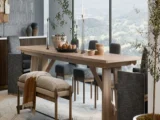
How to Mix and Match Sofa Upholstery in Open-Concept Spaces
April 12, 2025Open-concept living has become a hallmark of modern home design. These expansive layouts remove walls between the kitchen, dining, and living areas, creating a fluid, airy environment perfect for entertaining and daily living. But with that openness comes a unique design challenge — how to create visual harmony without making everything look the same.
One of the most powerful tools in defining and enhancing these open spaces is sofa upholstery Dubai . By thoughtfully mixing and matching fabrics, textures, and tones, you can bring warmth, character, and cohesion to even the largest open-plan areas.
In this post, we’ll guide you through how to mix and match sofa upholstery to elevate your space with confidence and style.
Why Upholstery Matters in Open-Concept Layouts
In an open-plan setting, furniture pieces are visible from multiple angles and spaces. Unlike closed-off rooms, you can’t rely on walls or separate color schemes to define each area. This means your sofas and upholstered furniture must do the heavy lifting in terms of:
Defining zones (e.g., reading nook vs. TV area)
Establishing mood or theme
Adding depth and dimension to the room
That’s where creative upholstery choices come in. Mixing different materials and colors adds contrast and visual interest — without the need for major structural changes.
Start with a Neutral Foundation
Before diving into bold mixes, choose a base tone that flows throughout the space. Neutrals like beige, gray, taupe, or soft white offer a timeless and versatile foundation.
Start with one primary sofa in a neutral, solid color. This acts as an anchor for the room, allowing you to layer in other textures or tones without overwhelming the space.
Pro tip: Choose a durable, easy-clean fabric for your primary seating if it’s the most used piece.
Play with Texture
One of the best ways to mix upholstery is by varying the textures. You might choose a sleek leather loveseat paired with a plush velvet armchair or contrast a linen sectional with a boucle accent chair.
Textures add a tactile richness and help distinguish different seating zones — ideal for open layouts where visual boundaries are minimal.
Great texture combos:
Velvet + Leather
Linen + Woven Cotton
Suede + Rattan Accents
Chenille + Performance Fabric
Not only do these combinations feel luxurious, but they also prevent the room from looking flat or monotonous.
Vary Tones within the Same Color Family
If you’re hesitant to go bold, a safe yet stylish way to mix upholstery is by staying within the same color family — just shift the tone or shade.
For example:
A light gray sofa with a charcoal accent chair
Warm beige paired with deeper camel or mocha
Soft blush pink with dusty rose or rust tones
This approach creates a layered, monochromatic palette that feels cohesive while still offering enough contrast to be interesting.
Introduce a Statement Piece
Every open space needs a moment of drama — and a statement upholstered piece can be just the thing.
Whether it’s a jewel-toned velvet chair, a patterned ottoman, or a sculptural bench in a bold fabric, this piece adds personality without throwing off the overall balance.
Keep it strategic:
Limit statement pieces to one or two per space.
Make sure the bold fabric echoes or complements colors used elsewhere (pillows, rugs, curtains, etc.).
This helps the statement stand out while still feeling connected to the overall design story.
Use Accessories to Tie It All Together
Throw pillows, rugs, and curtains are your secret weapons when blending upholstery styles. Use them to:
Repeat patterns or colors from one piece of furniture on another.
Add layers that bridge the gap between bold and neutral tones.
Introduce prints or accents that unite all the elements.
For example, if your sofa is gray and your armchair is navy, choose throw pillows that combine both tones, or a rug that pulls the colors together subtly.
Pro tip: Blackout curtains or textured drapes in a complementary fabric can help ground your upholstery choices while adding elegance and functionality.
Consider Proportions and Placement
In open spaces, scale and layout matter just as much as color and texture. Make sure each upholstered piece:
Fits its intended zone (not too large or too small)
Has enough breathing room
Balances the visual weight of other furniture
A bulky sectional might need to be balanced with a lighter accent chair or bench. Similarly, if you have two large fabric sofas, consider adding a sleeker leather piece or glass-topped coffee table to avoid heaviness.
Final Thoughts: Mix with Confidence, Not Chaos
Mixing and matching sofa upholstery Abu Dhabi in open-concept spaces doesn’t have to be intimidating. With the right approach — layering textures, coordinating colors, and playing with proportion — you can create a home that feels stylish, cozy, and effortlessly pulled together.
Remember, the goal isn’t to match everything perfectly — it’s to curate a thoughtful mix that reflects your style while embracing the natural flow of your space.







